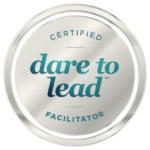
Leadership is about risk. For me, it began when I took a giant first step into the business ownership arena, full of hopes and dreams with no real idea what I was actually in for. How I faced the risks and challenges in the arena was what mattered. Getting up when I fell, dusting myself off and taking what I learned right back into the arena the following day.
Dr. Brené Brown is the author of Dare to Lead and an academic researcher. As part of her work, she set out to define and understand types of leadership. After interviewing more than 150 leaders in dozens of industries, she identified two distinct models: Armored Leadership and Daring Leadership.
Armored Leadership
To understand the differences, let’s start with armored leadership. The way it sounds is exactly what it is: a leader who suits up every day in an emotional armor, ready to do battle at work. Once one knows what to look for, it’s easy to spot:
- Armored leaders drive perfectionism and foster fear.
- They operate from a scarcity mindset, and
- because of that, they squander opportunities for joy and recognition, which are the foundation for collaboration and teamwork.
- They concentrate on knowing all the answers (whether they do or not) and insist on being right.
- Armored leaders tend to adopt a “power-over” style. (Power comes in at least three flavors: “power over” another person, “power to” accomplish or empowering others, and the power that is found within oneself.)
- They protect themselves with cynicism and criticism.
- They reward exhaustion as a status symbol.
- Finally, they promote a culture of “fitting in,” which, sadly, tolerates discrimination.
Armored leadership is common in organizations and governments. It can be effective, but at what cost? These are often the same businesses that struggle with issues of employee recruitment and retention, innovation, productivity, team building, and creating resilient organizational culture.
Daring Leadership
Daring leadership is very different. Rather that donning armor, a daring leader chooses to live, love and lead with a whole heart. What exactly does that mean?
- Daring leaders allow themselves to feel. They model clarity, kindness and hope.
- They encourage healthy striving, empathy and self-compassion.
- Daring leaders are learners. Rather than displaying a need to be right, they acquire the skills to get it right.
- They use “power with,” “power to,” and power within.
- They are skilled at acknowledging, naming and normalizing collective fear and uncertainty.
- They set appropriate boundaries by modeling and supporting rest, play and recovery.
- Daring leaders cultivate a shared purpose and a culture of belonging, inclusivity and diverse perspectives.
If someone had asked me 40 years ago, I’d have probably said these traits of daring leaders sounded soft, weak and ineffective. What I didn’t know at the time is, they were the definition of vulnerability. And vulnerability was not a term I’d have ever wanted to be associated with my leadership.
Today, after having had thousands of experiences of falling face-down in the business arena, I’ve learned that vulnerability — defined as risk, uncertainty and emotional exposure — has become the regular diet of my most meaningful leadership experiences. As Dr. Brown put it: “The courage to be vulnerable is not about winning or losing, it’s about the courage to show up when you can’t predict or control the outcome.”
As I said at the start, leadership truly is about risk. Whether we want to admit it or not, risk is almost always accompanied by fear.
Yet, leadership fear does not miraculously go away as many seem to believe. In fact, all the leaders Dr. Brown interviewed in her research said they were afraid every day. It is not fear that gets in the way of courage — it is armor. Daring leaders do not armor up.
I know now that courage is contagious and that we all have the capacity to learn it and practice it. There is no courage without vulnerability. By leaving my armor on the ground, I know I will show up with heart and create the opportunity to serve those I lead.
“Today we pay a lot of lip service to the idea of ‘bringing your whole self to work’ — yet the organizations that actually allow employees to do that are few and far between. . . . what I often observe is that many organizational cultures and leaders still subscribe to the myth that if we sever the heart (vulnerability and other emotions) from our work, we’ll be more productive, efficient, and (don’t forget) easier to manage …
“These beliefs lead us to consciously or unconsciously build cultures that require and reward armor…. where heart and emotion, especially vulnerability, are seen as liabilities . . .” —Dr. Brené Brown

 After 40 years as president of her print and marketing company, Eileen Rogers’ encore career is now as a leadership coach and business advisor through her company One Creative View. She is a seasoned and accomplished entrepreneur and recognized community leader who is fiercely passionate about supporting and growing more vulnerable and courageous leaders. She is a certified Dare to Lead™ facilitator, Integrative Enneagram practitioner and executive coach.
After 40 years as president of her print and marketing company, Eileen Rogers’ encore career is now as a leadership coach and business advisor through her company One Creative View. She is a seasoned and accomplished entrepreneur and recognized community leader who is fiercely passionate about supporting and growing more vulnerable and courageous leaders. She is a certified Dare to Lead™ facilitator, Integrative Enneagram practitioner and executive coach.














Speak Your Mind
You must be logged in to post a comment.